Healthcare Nursing Intervention: Medication and Patient Care
VerifiedAdded on 2023/06/03
|7
|1300
|440
Report
AI Summary
This report outlines a nursing intervention plan for a patient, Mrs. J, experiencing acute heart failure. The intervention begins with applying Maslow's ABC rule, addressing respiratory issues, and administering oxygen. The report details the patient's symptoms, including ventricular rate, atrial fibrillation, and the need for immediate hospitalization. It recommends monitoring vital signs, telemetry, daily weight, and lab tests such as liver function, CBC, D-dimer, and BNP. The report provides rationales for using specific medications like IV furosemide, enalapril, metoprolol, and IV morphine sulphate. It also discusses the impact of cardiovascular conditions such as smoking, high blood pressure, obesity, and sleep apnea. The nursing roles and interventions include educating patients on medication lists, adherence, and storage, and maintaining effective communication. The report references guidelines from the American College of Cardiology Foundation and American Heart Association, along with other relevant sources.
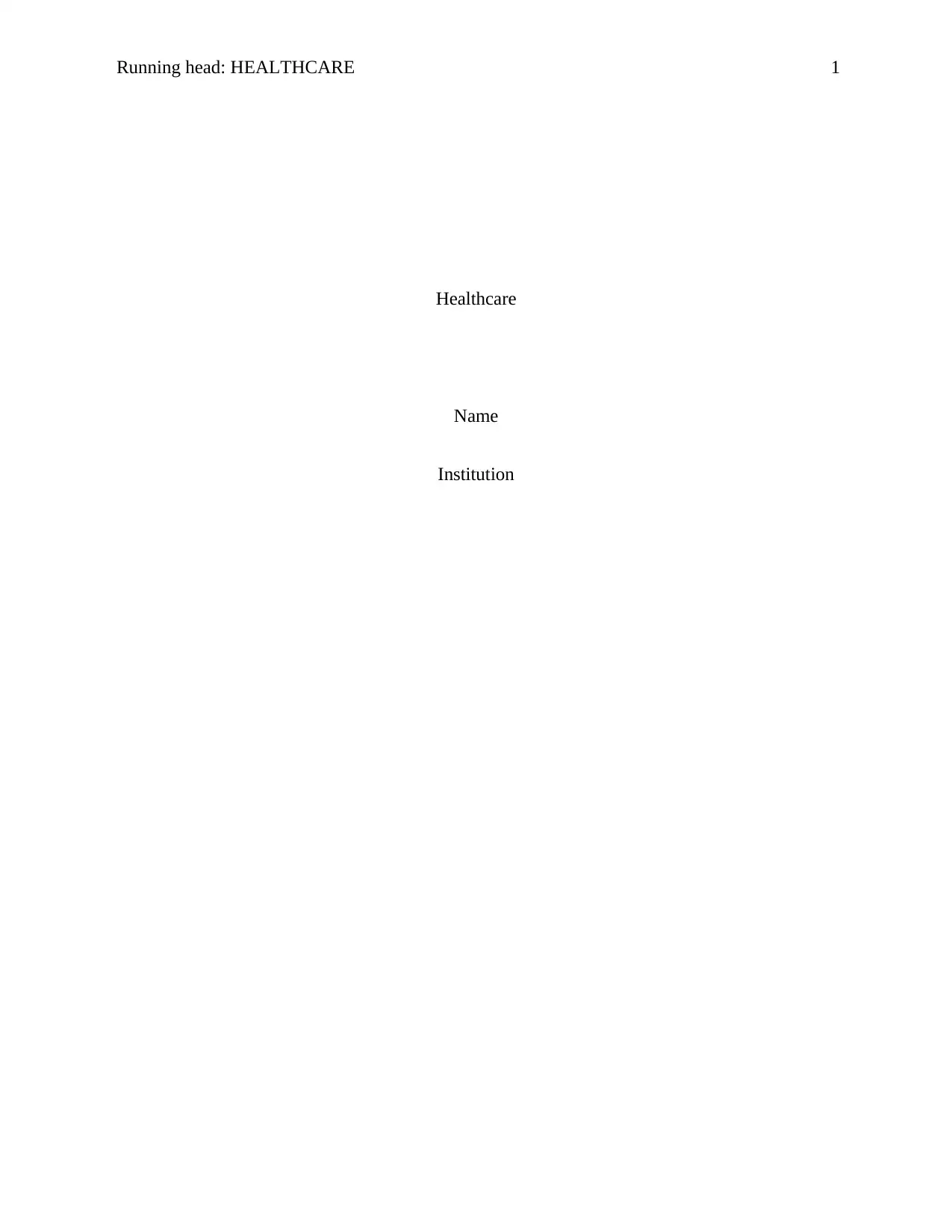
Running head: HEALTHCARE 1
Healthcare
Name
Institution
Healthcare
Name
Institution
Paraphrase This Document
Need a fresh take? Get an instant paraphrase of this document with our AI Paraphraser
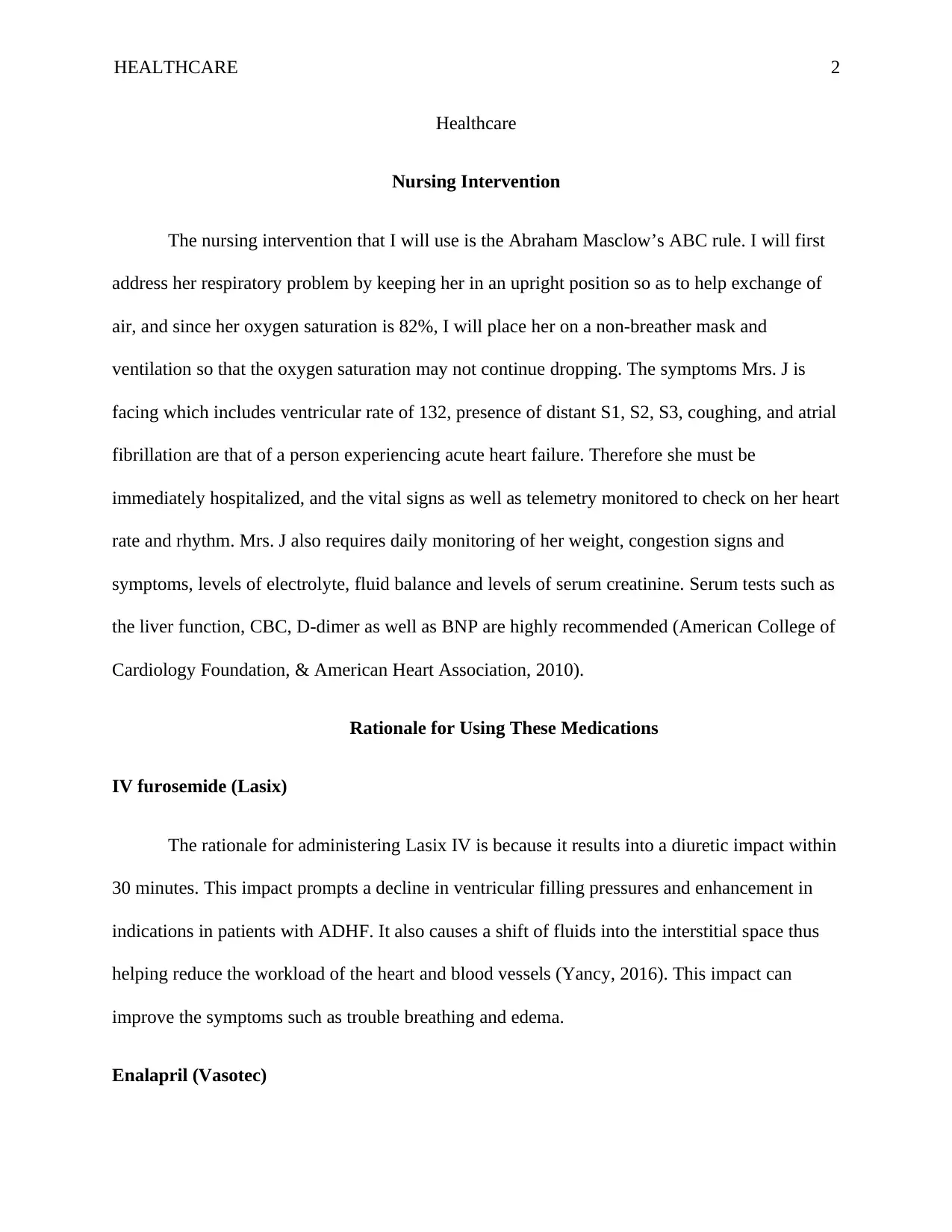
HEALTHCARE 2
Healthcare
Nursing Intervention
The nursing intervention that I will use is the Abraham Masclow’s ABC rule. I will first
address her respiratory problem by keeping her in an upright position so as to help exchange of
air, and since her oxygen saturation is 82%, I will place her on a non-breather mask and
ventilation so that the oxygen saturation may not continue dropping. The symptoms Mrs. J is
facing which includes ventricular rate of 132, presence of distant S1, S2, S3, coughing, and atrial
fibrillation are that of a person experiencing acute heart failure. Therefore she must be
immediately hospitalized, and the vital signs as well as telemetry monitored to check on her heart
rate and rhythm. Mrs. J also requires daily monitoring of her weight, congestion signs and
symptoms, levels of electrolyte, fluid balance and levels of serum creatinine. Serum tests such as
the liver function, CBC, D-dimer as well as BNP are highly recommended (American College of
Cardiology Foundation, & American Heart Association, 2010).
Rationale for Using These Medications
IV furosemide (Lasix)
The rationale for administering Lasix IV is because it results into a diuretic impact within
30 minutes. This impact prompts a decline in ventricular filling pressures and enhancement in
indications in patients with ADHF. It also causes a shift of fluids into the interstitial space thus
helping reduce the workload of the heart and blood vessels (Yancy, 2016). This impact can
improve the symptoms such as trouble breathing and edema.
Enalapril (Vasotec)
Healthcare
Nursing Intervention
The nursing intervention that I will use is the Abraham Masclow’s ABC rule. I will first
address her respiratory problem by keeping her in an upright position so as to help exchange of
air, and since her oxygen saturation is 82%, I will place her on a non-breather mask and
ventilation so that the oxygen saturation may not continue dropping. The symptoms Mrs. J is
facing which includes ventricular rate of 132, presence of distant S1, S2, S3, coughing, and atrial
fibrillation are that of a person experiencing acute heart failure. Therefore she must be
immediately hospitalized, and the vital signs as well as telemetry monitored to check on her heart
rate and rhythm. Mrs. J also requires daily monitoring of her weight, congestion signs and
symptoms, levels of electrolyte, fluid balance and levels of serum creatinine. Serum tests such as
the liver function, CBC, D-dimer as well as BNP are highly recommended (American College of
Cardiology Foundation, & American Heart Association, 2010).
Rationale for Using These Medications
IV furosemide (Lasix)
The rationale for administering Lasix IV is because it results into a diuretic impact within
30 minutes. This impact prompts a decline in ventricular filling pressures and enhancement in
indications in patients with ADHF. It also causes a shift of fluids into the interstitial space thus
helping reduce the workload of the heart and blood vessels (Yancy, 2016). This impact can
improve the symptoms such as trouble breathing and edema.
Enalapril (Vasotec)
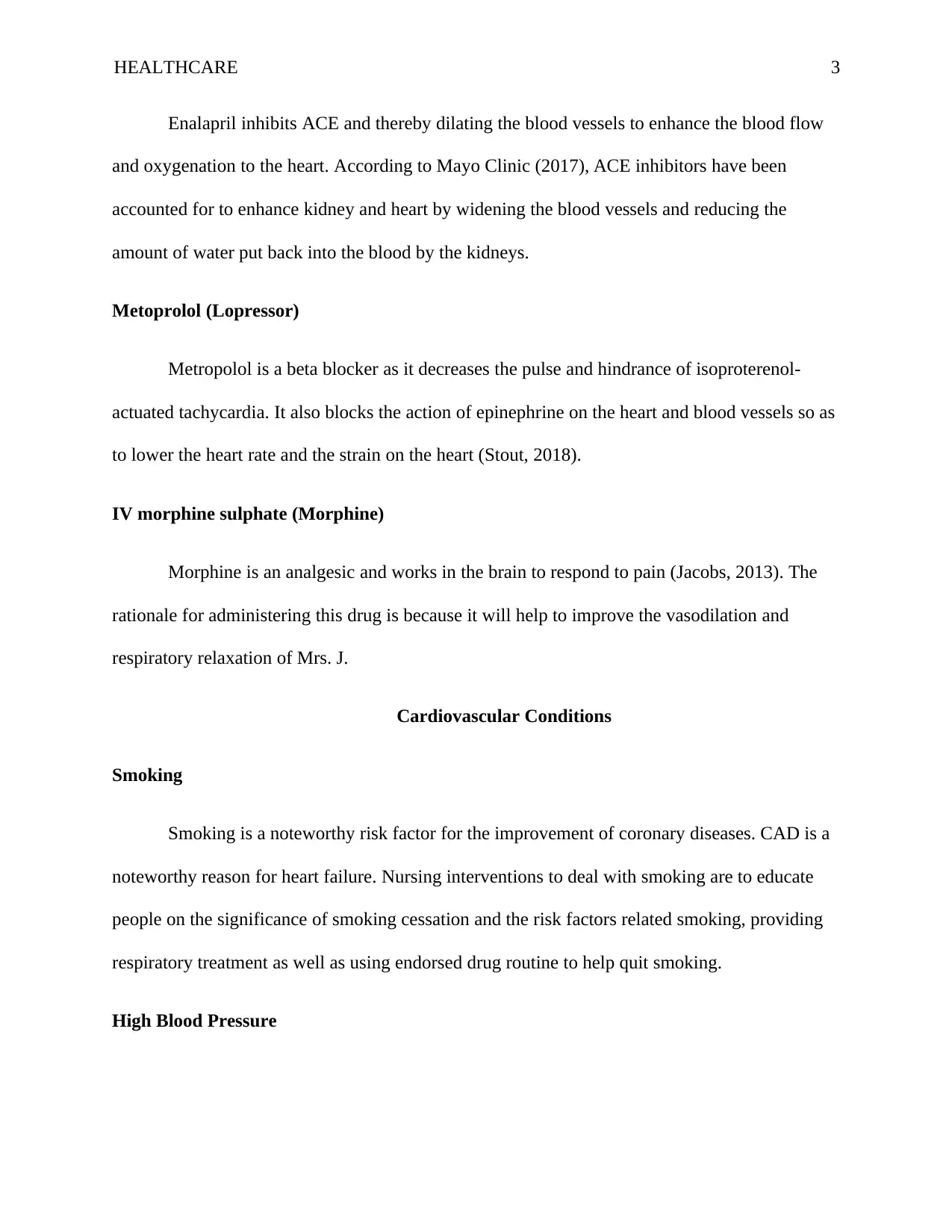
HEALTHCARE 3
Enalapril inhibits ACE and thereby dilating the blood vessels to enhance the blood flow
and oxygenation to the heart. According to Mayo Clinic (2017), ACE inhibitors have been
accounted for to enhance kidney and heart by widening the blood vessels and reducing the
amount of water put back into the blood by the kidneys.
Metoprolol (Lopressor)
Metropolol is a beta blocker as it decreases the pulse and hindrance of isoproterenol-
actuated tachycardia. It also blocks the action of epinephrine on the heart and blood vessels so as
to lower the heart rate and the strain on the heart (Stout, 2018).
IV morphine sulphate (Morphine)
Morphine is an analgesic and works in the brain to respond to pain (Jacobs, 2013). The
rationale for administering this drug is because it will help to improve the vasodilation and
respiratory relaxation of Mrs. J.
Cardiovascular Conditions
Smoking
Smoking is a noteworthy risk factor for the improvement of coronary diseases. CAD is a
noteworthy reason for heart failure. Nursing interventions to deal with smoking are to educate
people on the significance of smoking cessation and the risk factors related smoking, providing
respiratory treatment as well as using endorsed drug routine to help quit smoking.
High Blood Pressure
Enalapril inhibits ACE and thereby dilating the blood vessels to enhance the blood flow
and oxygenation to the heart. According to Mayo Clinic (2017), ACE inhibitors have been
accounted for to enhance kidney and heart by widening the blood vessels and reducing the
amount of water put back into the blood by the kidneys.
Metoprolol (Lopressor)
Metropolol is a beta blocker as it decreases the pulse and hindrance of isoproterenol-
actuated tachycardia. It also blocks the action of epinephrine on the heart and blood vessels so as
to lower the heart rate and the strain on the heart (Stout, 2018).
IV morphine sulphate (Morphine)
Morphine is an analgesic and works in the brain to respond to pain (Jacobs, 2013). The
rationale for administering this drug is because it will help to improve the vasodilation and
respiratory relaxation of Mrs. J.
Cardiovascular Conditions
Smoking
Smoking is a noteworthy risk factor for the improvement of coronary diseases. CAD is a
noteworthy reason for heart failure. Nursing interventions to deal with smoking are to educate
people on the significance of smoking cessation and the risk factors related smoking, providing
respiratory treatment as well as using endorsed drug routine to help quit smoking.
High Blood Pressure
⊘ This is a preview!⊘
Do you want full access?
Subscribe today to unlock all pages.

Trusted by 1+ million students worldwide
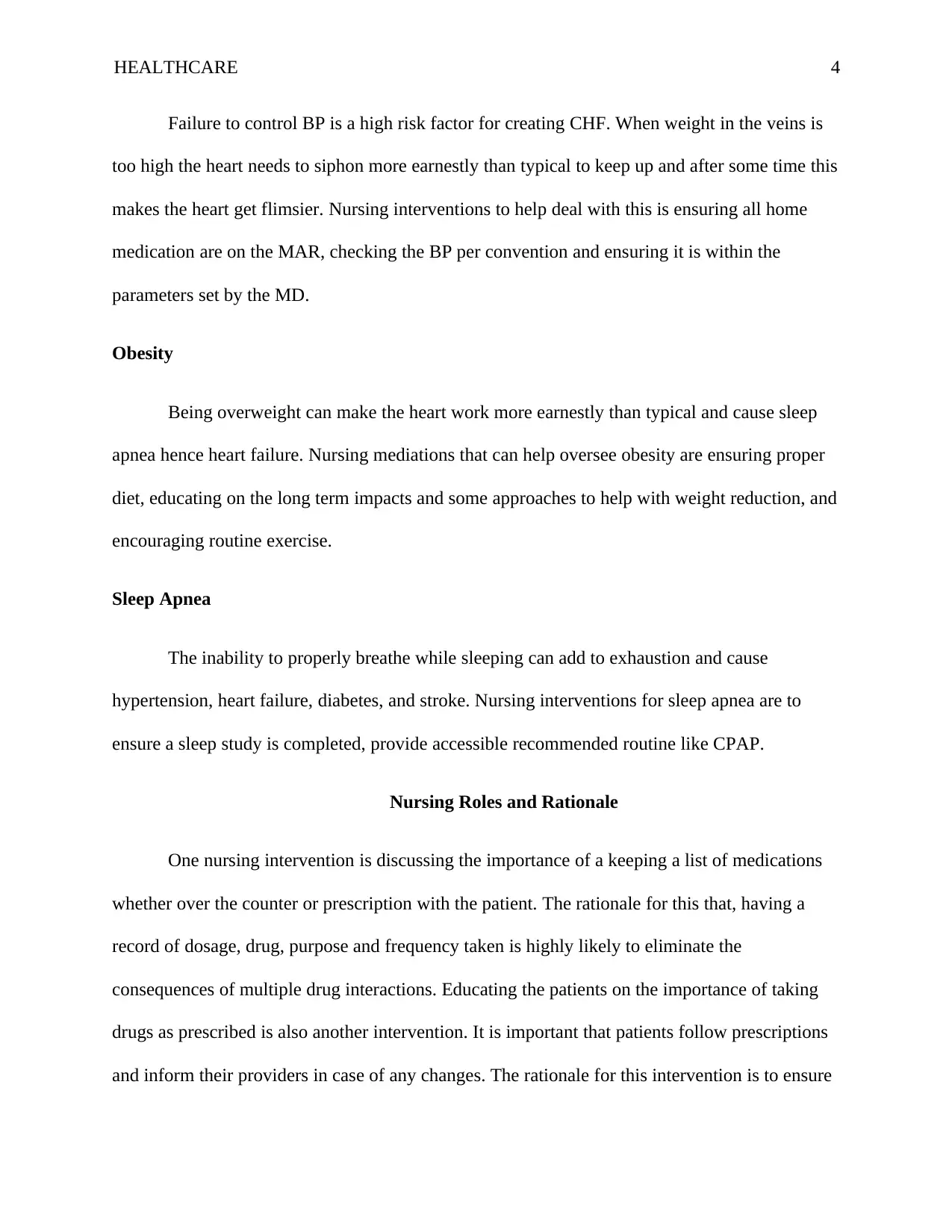
HEALTHCARE 4
Failure to control BP is a high risk factor for creating CHF. When weight in the veins is
too high the heart needs to siphon more earnestly than typical to keep up and after some time this
makes the heart get flimsier. Nursing interventions to help deal with this is ensuring all home
medication are on the MAR, checking the BP per convention and ensuring it is within the
parameters set by the MD.
Obesity
Being overweight can make the heart work more earnestly than typical and cause sleep
apnea hence heart failure. Nursing mediations that can help oversee obesity are ensuring proper
diet, educating on the long term impacts and some approaches to help with weight reduction, and
encouraging routine exercise.
Sleep Apnea
The inability to properly breathe while sleeping can add to exhaustion and cause
hypertension, heart failure, diabetes, and stroke. Nursing interventions for sleep apnea are to
ensure a sleep study is completed, provide accessible recommended routine like CPAP.
Nursing Roles and Rationale
One nursing intervention is discussing the importance of a keeping a list of medications
whether over the counter or prescription with the patient. The rationale for this that, having a
record of dosage, drug, purpose and frequency taken is highly likely to eliminate the
consequences of multiple drug interactions. Educating the patients on the importance of taking
drugs as prescribed is also another intervention. It is important that patients follow prescriptions
and inform their providers in case of any changes. The rationale for this intervention is to ensure
Failure to control BP is a high risk factor for creating CHF. When weight in the veins is
too high the heart needs to siphon more earnestly than typical to keep up and after some time this
makes the heart get flimsier. Nursing interventions to help deal with this is ensuring all home
medication are on the MAR, checking the BP per convention and ensuring it is within the
parameters set by the MD.
Obesity
Being overweight can make the heart work more earnestly than typical and cause sleep
apnea hence heart failure. Nursing mediations that can help oversee obesity are ensuring proper
diet, educating on the long term impacts and some approaches to help with weight reduction, and
encouraging routine exercise.
Sleep Apnea
The inability to properly breathe while sleeping can add to exhaustion and cause
hypertension, heart failure, diabetes, and stroke. Nursing interventions for sleep apnea are to
ensure a sleep study is completed, provide accessible recommended routine like CPAP.
Nursing Roles and Rationale
One nursing intervention is discussing the importance of a keeping a list of medications
whether over the counter or prescription with the patient. The rationale for this that, having a
record of dosage, drug, purpose and frequency taken is highly likely to eliminate the
consequences of multiple drug interactions. Educating the patients on the importance of taking
drugs as prescribed is also another intervention. It is important that patients follow prescriptions
and inform their providers in case of any changes. The rationale for this intervention is to ensure
Paraphrase This Document
Need a fresh take? Get an instant paraphrase of this document with our AI Paraphraser
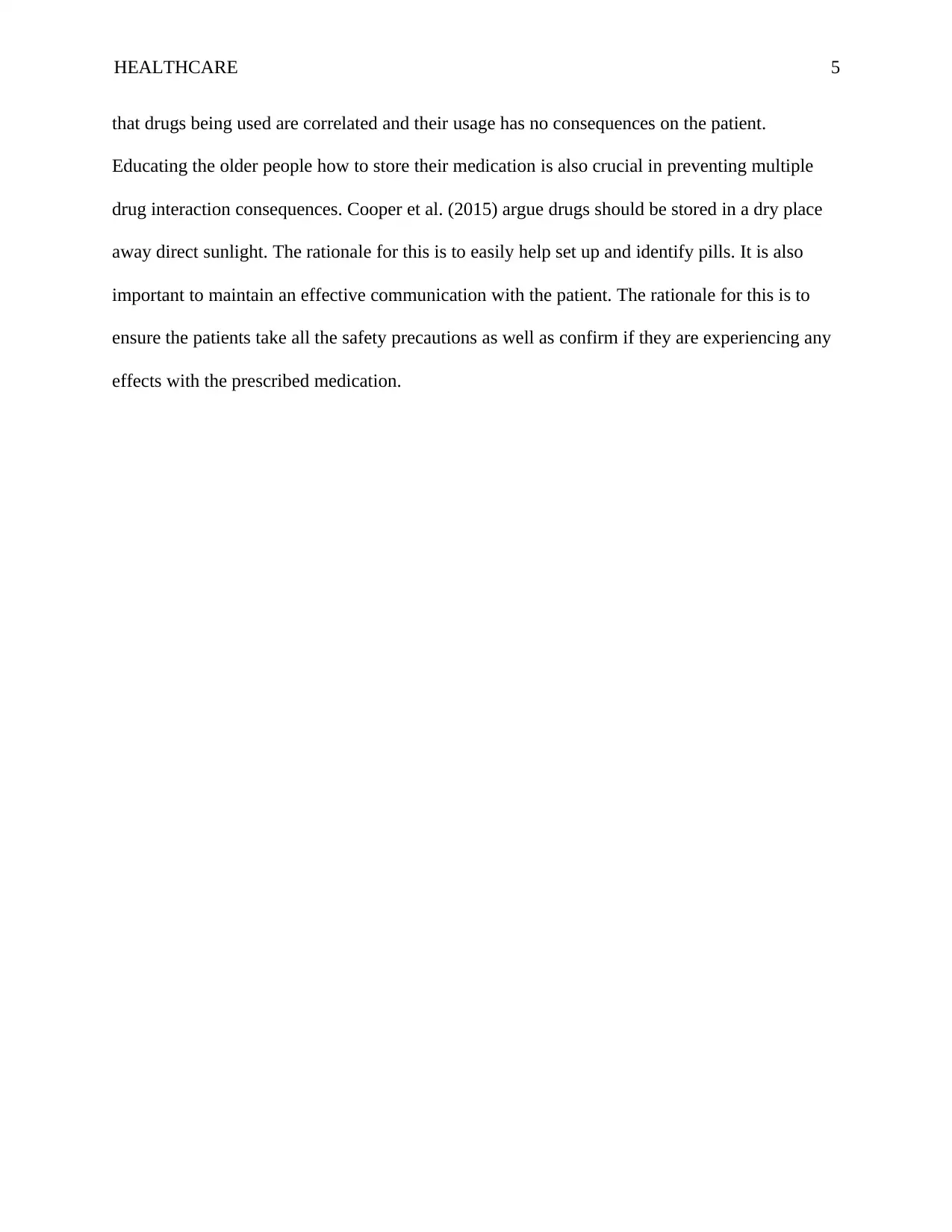
HEALTHCARE 5
that drugs being used are correlated and their usage has no consequences on the patient.
Educating the older people how to store their medication is also crucial in preventing multiple
drug interaction consequences. Cooper et al. (2015) argue drugs should be stored in a dry place
away direct sunlight. The rationale for this is to easily help set up and identify pills. It is also
important to maintain an effective communication with the patient. The rationale for this is to
ensure the patients take all the safety precautions as well as confirm if they are experiencing any
effects with the prescribed medication.
that drugs being used are correlated and their usage has no consequences on the patient.
Educating the older people how to store their medication is also crucial in preventing multiple
drug interaction consequences. Cooper et al. (2015) argue drugs should be stored in a dry place
away direct sunlight. The rationale for this is to easily help set up and identify pills. It is also
important to maintain an effective communication with the patient. The rationale for this is to
ensure the patients take all the safety precautions as well as confirm if they are experiencing any
effects with the prescribed medication.
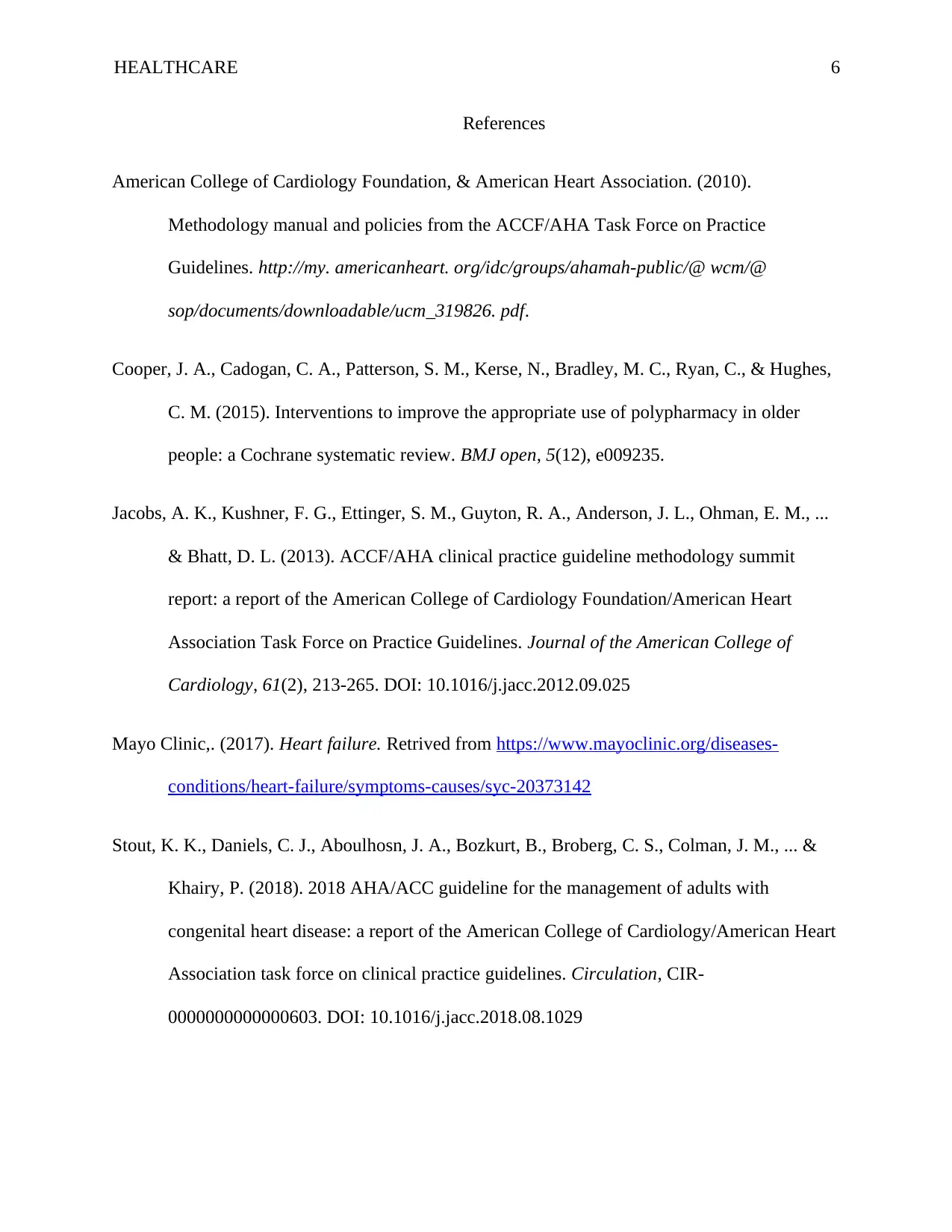
HEALTHCARE 6
References
American College of Cardiology Foundation, & American Heart Association. (2010).
Methodology manual and policies from the ACCF/AHA Task Force on Practice
Guidelines. http://my. americanheart. org/idc/groups/ahamah-public/@ wcm/@
sop/documents/downloadable/ucm_319826. pdf.
Cooper, J. A., Cadogan, C. A., Patterson, S. M., Kerse, N., Bradley, M. C., Ryan, C., & Hughes,
C. M. (2015). Interventions to improve the appropriate use of polypharmacy in older
people: a Cochrane systematic review. BMJ open, 5(12), e009235.
Jacobs, A. K., Kushner, F. G., Ettinger, S. M., Guyton, R. A., Anderson, J. L., Ohman, E. M., ...
& Bhatt, D. L. (2013). ACCF/AHA clinical practice guideline methodology summit
report: a report of the American College of Cardiology Foundation/American Heart
Association Task Force on Practice Guidelines. Journal of the American College of
Cardiology, 61(2), 213-265. DOI: 10.1016/j.jacc.2012.09.025
Mayo Clinic,. (2017). Heart failure. Retrived from https://www.mayoclinic.org/diseases-
conditions/heart-failure/symptoms-causes/syc-20373142
Stout, K. K., Daniels, C. J., Aboulhosn, J. A., Bozkurt, B., Broberg, C. S., Colman, J. M., ... &
Khairy, P. (2018). 2018 AHA/ACC guideline for the management of adults with
congenital heart disease: a report of the American College of Cardiology/American Heart
Association task force on clinical practice guidelines. Circulation, CIR-
0000000000000603. DOI: 10.1016/j.jacc.2018.08.1029
References
American College of Cardiology Foundation, & American Heart Association. (2010).
Methodology manual and policies from the ACCF/AHA Task Force on Practice
Guidelines. http://my. americanheart. org/idc/groups/ahamah-public/@ wcm/@
sop/documents/downloadable/ucm_319826. pdf.
Cooper, J. A., Cadogan, C. A., Patterson, S. M., Kerse, N., Bradley, M. C., Ryan, C., & Hughes,
C. M. (2015). Interventions to improve the appropriate use of polypharmacy in older
people: a Cochrane systematic review. BMJ open, 5(12), e009235.
Jacobs, A. K., Kushner, F. G., Ettinger, S. M., Guyton, R. A., Anderson, J. L., Ohman, E. M., ...
& Bhatt, D. L. (2013). ACCF/AHA clinical practice guideline methodology summit
report: a report of the American College of Cardiology Foundation/American Heart
Association Task Force on Practice Guidelines. Journal of the American College of
Cardiology, 61(2), 213-265. DOI: 10.1016/j.jacc.2012.09.025
Mayo Clinic,. (2017). Heart failure. Retrived from https://www.mayoclinic.org/diseases-
conditions/heart-failure/symptoms-causes/syc-20373142
Stout, K. K., Daniels, C. J., Aboulhosn, J. A., Bozkurt, B., Broberg, C. S., Colman, J. M., ... &
Khairy, P. (2018). 2018 AHA/ACC guideline for the management of adults with
congenital heart disease: a report of the American College of Cardiology/American Heart
Association task force on clinical practice guidelines. Circulation, CIR-
0000000000000603. DOI: 10.1016/j.jacc.2018.08.1029
⊘ This is a preview!⊘
Do you want full access?
Subscribe today to unlock all pages.

Trusted by 1+ million students worldwide
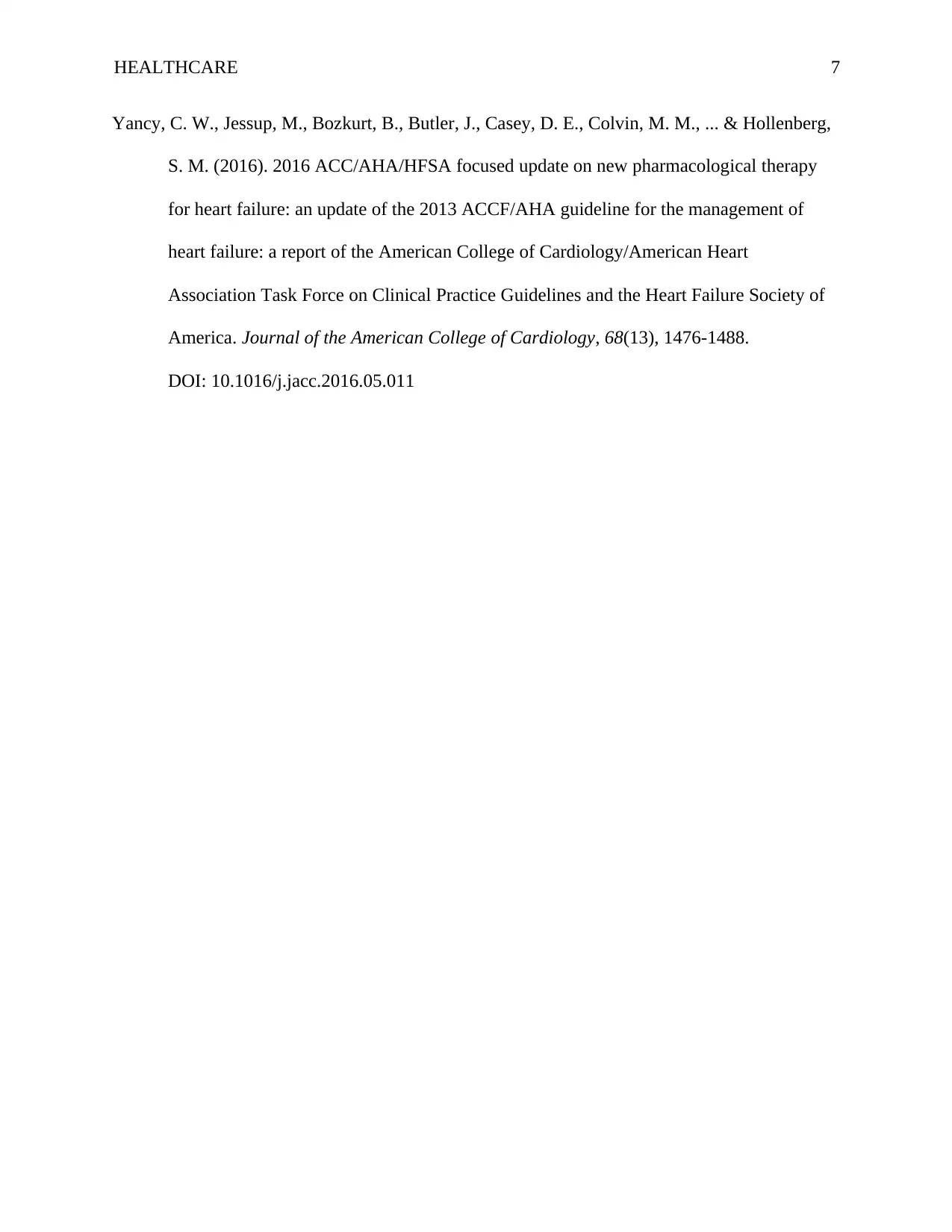
HEALTHCARE 7
Yancy, C. W., Jessup, M., Bozkurt, B., Butler, J., Casey, D. E., Colvin, M. M., ... & Hollenberg,
S. M. (2016). 2016 ACC/AHA/HFSA focused update on new pharmacological therapy
for heart failure: an update of the 2013 ACCF/AHA guideline for the management of
heart failure: a report of the American College of Cardiology/American Heart
Association Task Force on Clinical Practice Guidelines and the Heart Failure Society of
America. Journal of the American College of Cardiology, 68(13), 1476-1488.
DOI: 10.1016/j.jacc.2016.05.011
Yancy, C. W., Jessup, M., Bozkurt, B., Butler, J., Casey, D. E., Colvin, M. M., ... & Hollenberg,
S. M. (2016). 2016 ACC/AHA/HFSA focused update on new pharmacological therapy
for heart failure: an update of the 2013 ACCF/AHA guideline for the management of
heart failure: a report of the American College of Cardiology/American Heart
Association Task Force on Clinical Practice Guidelines and the Heart Failure Society of
America. Journal of the American College of Cardiology, 68(13), 1476-1488.
DOI: 10.1016/j.jacc.2016.05.011
1 out of 7
Related Documents
Your All-in-One AI-Powered Toolkit for Academic Success.
+13062052269
info@desklib.com
Available 24*7 on WhatsApp / Email
![[object Object]](/_next/static/media/star-bottom.7253800d.svg)
Unlock your academic potential
Copyright © 2020–2025 A2Z Services. All Rights Reserved. Developed and managed by ZUCOL.





